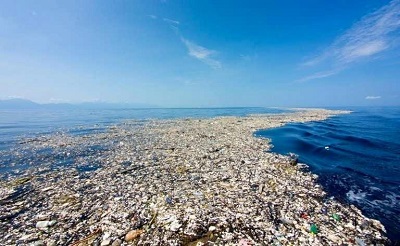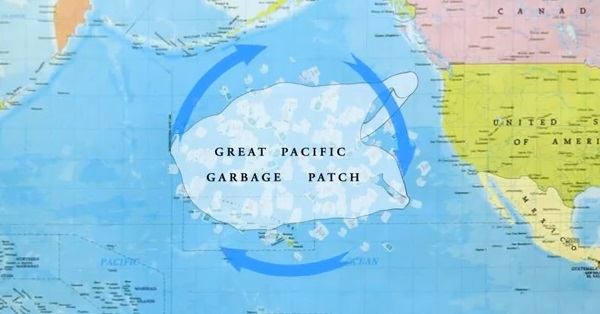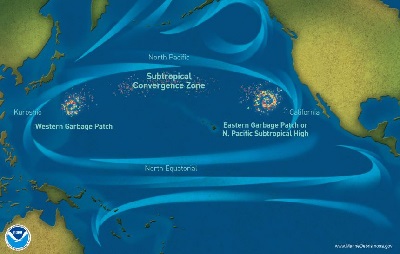Where’s the Great Garbage Patch?
Do you know that there’s a gigantic floating mass of garbage in the Pacific Ocean that’s three times the size of France?
Do you know that there’s a gigantic floating mass of garbage in the Pacific Ocean that’s three times the size of France?
That’s true.
Here’s all about it
What’s the great pacific garbage patch?

The Great Pacific Garbage Patch is located in the northern part of the Pacific Ocean between California and Hawaii. There’s about 79000 tons of plastic debris in this patch – with some 1.8 trillion pieces of plastic.

Also known as the ‘Pacific trash vortex’, this is the largest known patch of garbage lying afloat on the sea surface. Its spread across 1.6 million square kilometres in the northern central region of the Pacific ocean. A plastic mass of this colossal area can engulf half of India, the 7th largest country on earth!
Who found this?

So this great garbage patch was discovered by an American Oceanographer named Captain Charles Moore in 1997. He was returning home and took a route in the sea that seemed to be full of plastic. He said that it took a week to cross the north pacific and no matter what time of day he looked, plastic debris was floating everywhere: bottles, bottle caps, wrappers, fragments and so on.
How is it formed?
The great pacific garbage patch was formed with, what’s called, marine debris (debris means scattered rubbish or remains) and microplastics in two massive whirlpools of human waste that have come to be known as the Western Garbage Patch (closer to Japan) and the Eastern Garbage Patch (closer to California and Mexico).
Marine debris is any solid material that ends up in the marine environment or the Great Lakes. Microplastics are tiny flakes of plastic that can’t always be seen by the naked eye. So in reality it looks like a milky broth served with tons of plastic croutons and microplastic flavouring, unlike the plastic island you might have imagined!
Why does the plastic not float away?

The entire Great Pacific Garbage Patch is bounded by the North Pacific Subtropical Gyre. A gyre is a dynamic system of ocean currents. These ocean currents are circular and entrap marine debris. More or less like a whirlpool where the garbage keep going round and round.
The marine debris swirls with the circular currents and ends up landing in the centre of the gyre suggesting that the centre of the gyre is relatively stable. Concisely the plastic gets trapped.
Where does this plastic come from?
Almost 8-12 million tons of plastic waste ends up in ocean bodies wherein 80 percent of plastic is estimated to come from land-based sources, with the remaining 20 percent coming from boats, the grand cruise ships, the navy, and other marine sources.
Most of this debris comes from Single-use plastic like plastic bags, bottle caps, plastic water bottles, and Styrofoam cups
A 2018 study found that synthetic fishing nets made up nearly half the mass of the Great Pacific Garbage Patch.
About 70% of plastic sinks!
and while some of it ends up washing ashore creating unsightly plastic heaps, most of the plastic waste ends up in the ocean. The lighter plastics get caught in gyres but the heavier plastic sinks to the ocean floor interfering with seafloor habitat
What about marine life?
Marine life refers to the living organisms in the oceans. In the ocean, the sun breaks down these plastics into minute pieces, a process known as photodegradation producing microplastics.
The fishes eat microplastics taking it for planktons (these are tiny floating animals that fishes snack on). And this becomes toxic for them. ALso, eating plastic waste makes the animals feel full and so they don’t eat the nutritious or right food and eventually die of starvation or lack of nutrition.
The microplastics make the ocean environment even more lethal for fishes that inhale and exhale water every few seconds and sea birds such as Albatrosses mistake plastic waste for fish eggs and feed them to baby chicks which die of starvation.
Lost fishing nets are especially dangerous. They are often called “ghost” nets because they continue to fish even though they are no longer under the control of a fisher
The environment
The photodegradation of plastic releases greenhouse gases adding to global warming. Greenhouse gases are the gases that entrap the heat of solar rays and increase the earth’s overall temperature which leads to the melting of glaciers and other catastrophes.
What about cleaning the great garbage patch?
A non-profit environmental organisation ‘The Ocean Cleanup’ has taken the responsibility for cleaning the great garbage patch. They’ve been collecting plastic waste using a 600-metre floating barrier. The first haul of waste, cleared from the Great Pacific Garbage Patch, has been returned to shore
It’s difficult to clean the garbage patch by using enormous nets as it risks trapping the marine life in the trash but the organisation is using a vessel named jenny to carry out this magnanimous task.
What should you do?
Let’s face it! We’ve littered our only planet beyond the point of no return. With 70% of the total earth’s surface being water Scientists and explorers believe that the ocean floor is polluted beyond measure. The best way to clean up the Great Pacific Garbage Patch is to limit or eliminate our use of disposable plastics and increase our use of biodegradable resources.
Avoid single-use plastics as much as possible. If you live near the beach volunteer to clean up the shores. Don’t forget that the smallest effort counts in the fight against plastic pollution.
I Kid You Not now has a large readership across India and also parts of the world. If you want to write for us, you can submit your story here. You can also apply to become a news anchor. Apply here



Comments